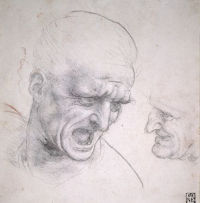The Body of Man Click on the thumbnails to explore the trail
Read more about this trail (expand)
According to Leonardo, man himself was at the centre of everything– “The measure of all things”. Throughout his life, the artist engaged in a dynamic and increasingly in-depth examination of man as a living organism, embarking on a seemingly unending quest to discover how man moved, grew, developed and perceived the world in which he lived.
Studies of the heads of two soldiers in the Battle of Anghiari c1503
Leonardo advised that in paintings the actions of figures should express the purposes of their minds.
In this preparatory drawing for two of the leading warriors in the lost Battle of Anghiari fresco, Leonardo exploits the medium to achieve maximum expressive force. Parallel chalk hatching lines are smudged to create a seamless, blended sfumato, or “smoky”, effect in the rendering of shadows. This modelling conveys the three-dimensional form of the head seen in three-quarter view and the dynamic facial expression.
The deep incised lines of the face are forcefully drawn with the sharp point of the chalk to convey the shouting action. This soldier is thought to represent Niccolò Piccinino, the Condottiere in command of the Milanese troops of the Duke Filippo Maria Visconti defeated by the Florentines in the battle of Anghiari.
Ruben’s copy of Leonardo’s lost fresco suggests that the grimacing profile on the right is a study for the soldiers who appears to Niccolò’s right in the painting. The lack of definition of the upper parts of both heads relates to the fact that in the final design the figures were portrayed with elaborate headgear.
In Leoanrdo's words
Make the motions of your figures appropriate to the mental conditions of these figures; that is to say if you have to depict he who is enraged his face should not display anything opposing this emotion; rather, nothing other than rage should be judged to be present there – and similarly for joy, melancholy, mirth, tears and such like.
In this masterful study, a preparatory drawing for two of the leading warriors in The Battle of Anghiari fresco, Leonardo exploits the chalk or charcoal medium in order to achieve maximum force of expression, smudging the parallel hatched lines in order to create a seamless, blended sfumato, or “smoky”, effect in the rendering of shadows.
The vigour of the main figure is perfectly captured by the technique, with the deep, incised lines of the face forcefully delineated using the sharp point of the chalk.
This figure – a screaming soldier seen in three-quarter view, facing right, is usually thought to represent Niccolò Piccinino, the condottiere in command of the Milanese troops of the Duke Filippo Maria Visconti, who were defeated by the Florentines. The profile is a study for one of the soldiers to his right.
The lack of definition of the upper part of both heads probably relates to the fact that in the final design the figures would have been portrayed with headgear.
- Medium Charcoal or soft balck chalk; some traces of red chalk on left
- Size 19.2 x 18.8 cm
- Location Szépmüvészeti Múzeum











